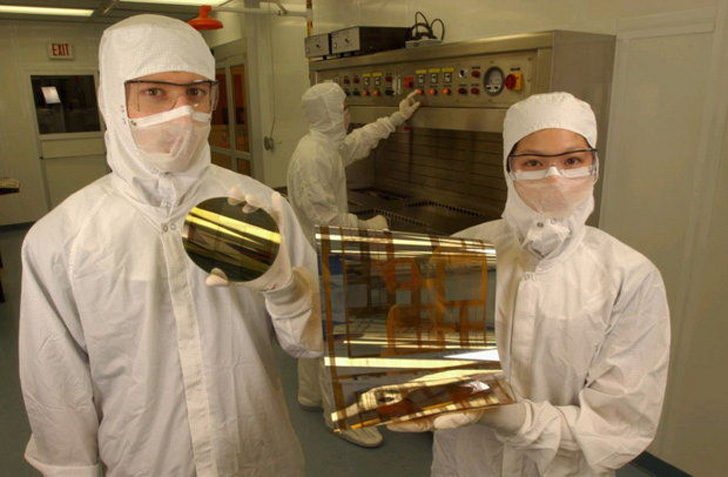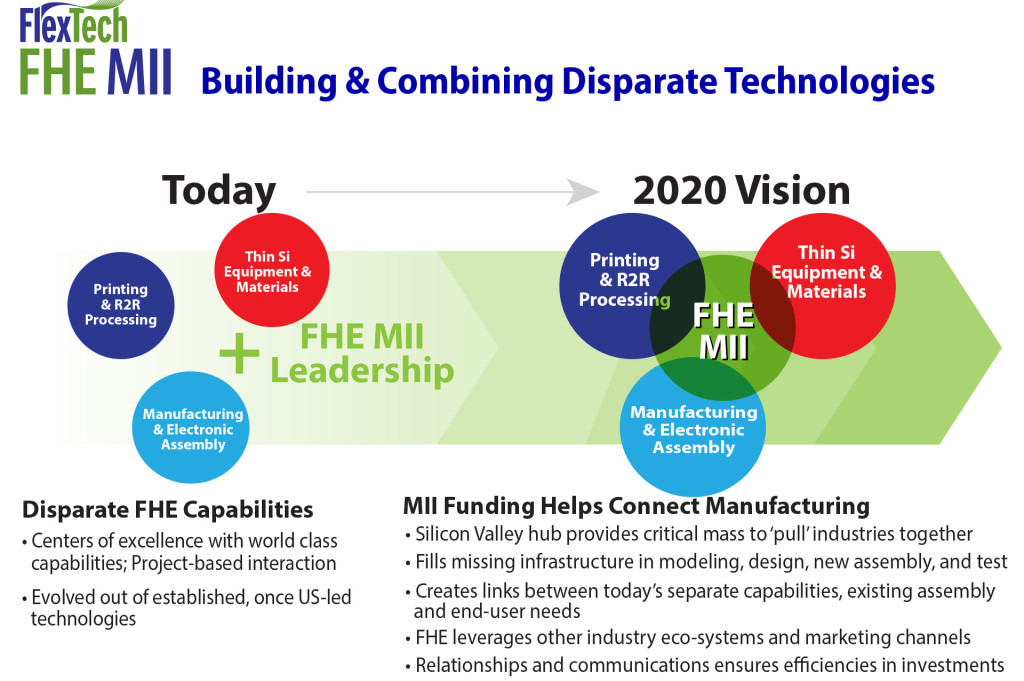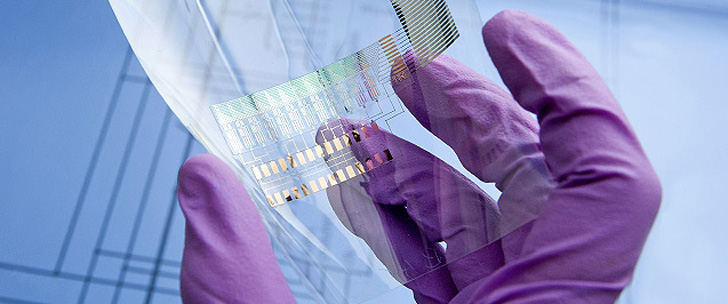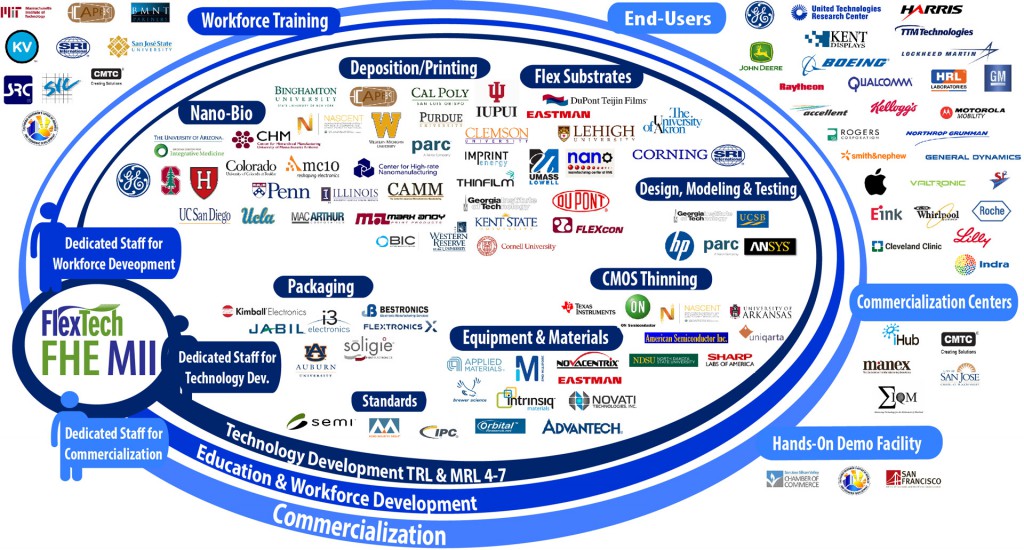Having already established the pilot America Makes 3D printing institute and deeming it a success, the US government is in the process of establishing a National Network for Manufacturing Innovation across the country. Today, a ninth institute was formed, this time, dedicated to flexible electronics, but this latest initiative is getting a lot more press than many of the others, from publications including Forbes, Reuters, and more. What makes the Manufacturing Innovation Institute (MII) for Flexible Hybrid Electronics (FHE MII) stand out from the rest? It’s being run by the San Jose-based FlexTech Alliance, an organization made up of over one hundred members that include such huge Silicon Valley names as Apple and HP. And, in tandem with the US Department of Defense, the consortium will work to create flexible electronics for the US military.
Up until now, the NNMI already consisted of the Digital Lab in Chicago, dedicated to 3D printing, the Lightweight and Modern Metals Manufacturing Innovation in Detroit, and four others with focuses ranging from semiconductors to textiles. And, while most of these initiatives have seen heavy involvement from industry, particularly from aerospace and defense manufacturers, the FHE MII is being established by FlexTech Alliance, which includes 162 companies, nonprofits, labs, and universities that, along with the tech giants mentioned above, feature Boeing, General Motors, Stanford, Motorola, the City of San Jose, a few US states, and numerous others.
Over the course of the next five years, the U.S. Department of Defense (DoD) will award FlexTech $75 million in federal funding, which will be matched by its members to the tune of $96 million in cost-sharing. And, though the US will eventually form along the lines of 45 different NNMIs, the FHE MII will be the first of seven on the West Coast. Much like America Makes, the FHE MII will award funds to individual research endeavors based on competitively-bid project calls seeking to drive progress in flexible electronics manufacturing. Additionally, a “Flex School” will be created with community colleges, universities, trade associations, and professional societies.
In a press release on the subject the FHE MII described the technology it will be working to develop, “Flexible hybrid electronics, an emerging manufacturing capability, enables the integration of thin silicon electronic devices, sensing elements, communications, and power on non-traditional flexible substrates. FHE has the potential to re-shape entire industries, from the electronic wearable devices market, to medical health monitoring systems, to the ubiquitous sensing of the world around us – also known as the Internet of Things. To be successful, the Institute will need to engage aspects of the integrated circuit (IC) industry, the graphics printing industry, and the electronic assembly/packaging industry.”
Om Nalamasu, FlexTech Board Member and CTO of Applied Materials, elaborates a bit more on the nature of the devices they might create, “FHE is truly an exciting proposition and represents public-private collaboration in the United States at its finest. The electronics advancements enabled by FHE allow us to imagine medical devices that can unobtrusively safeguard the health of senior citizens, wearable health monitoring for fitness and security, and soft robotics for the injured, elderly or our wounded veterans.”
A lot of news sources are paying particular attention to the fact that Apple, HP, and others will be involved in the project and that may very well be the case, but, so far, very few of the 162 member organizations have given any input on the formation of the FHE MII. The image above illustrates, however, that Apple, as well as Kellogg, GE, Roche, Boeing, Lockheed Martin, and others will be the end users of their projects over the next five years. What the graphic doesn’t indicate is that any of the developments made by the FHE MII will make it back into the public sphere, other than through manufactured goods and any educational programs at public universities and community colleges, despite the $75 million of public funding.
This means that, any wearable developed by Apple, which will be made privy to the DoD and FHE MII members first, will be paid for twice over by customers that purchase them later on. And, though such a product will aid the members of the consortium and the DoD, it is not necessarily something that taxpayers have voted for spending their money on. Because the NNMI is growing and securing public funding with each institute, it’s important to understand that, from the start, the initiative has not been driven by the public. Even before the formation of America Makes, the very concept for the NNMI was created by the Advanced Manufacturing Partnership (AMP) Steering Committee, consisting of the CEOs of Dow Chemical, Northrop Grumman, Honeywell, Procter and Gamble, Intel, Caterpillar, Allegheny Technologies, Ford Motor Company, and Johnson & Johnson.
This is the fifth NNMI institute to be controlled by the DoD, out of nine total, and there are 36 more to go. As exciting as the technology that comes out of them will be, many US citizens may wonder if there are more pressing needs on which to spend their tax dollars.






